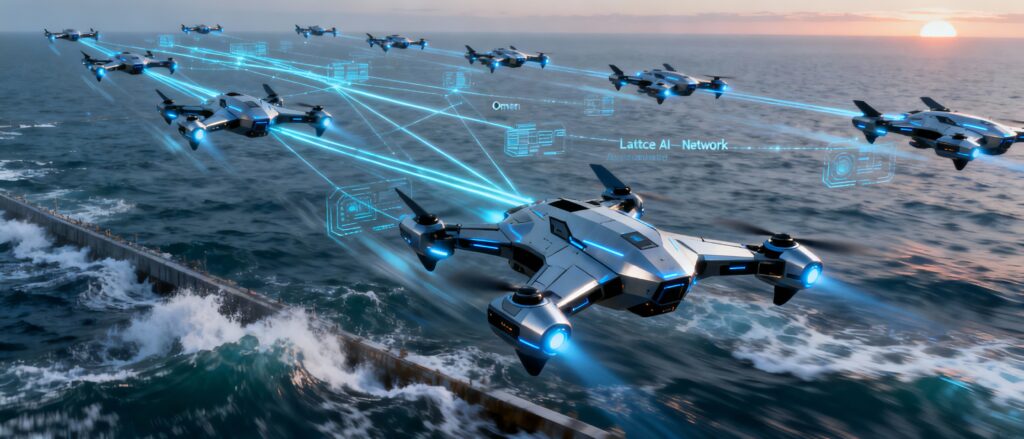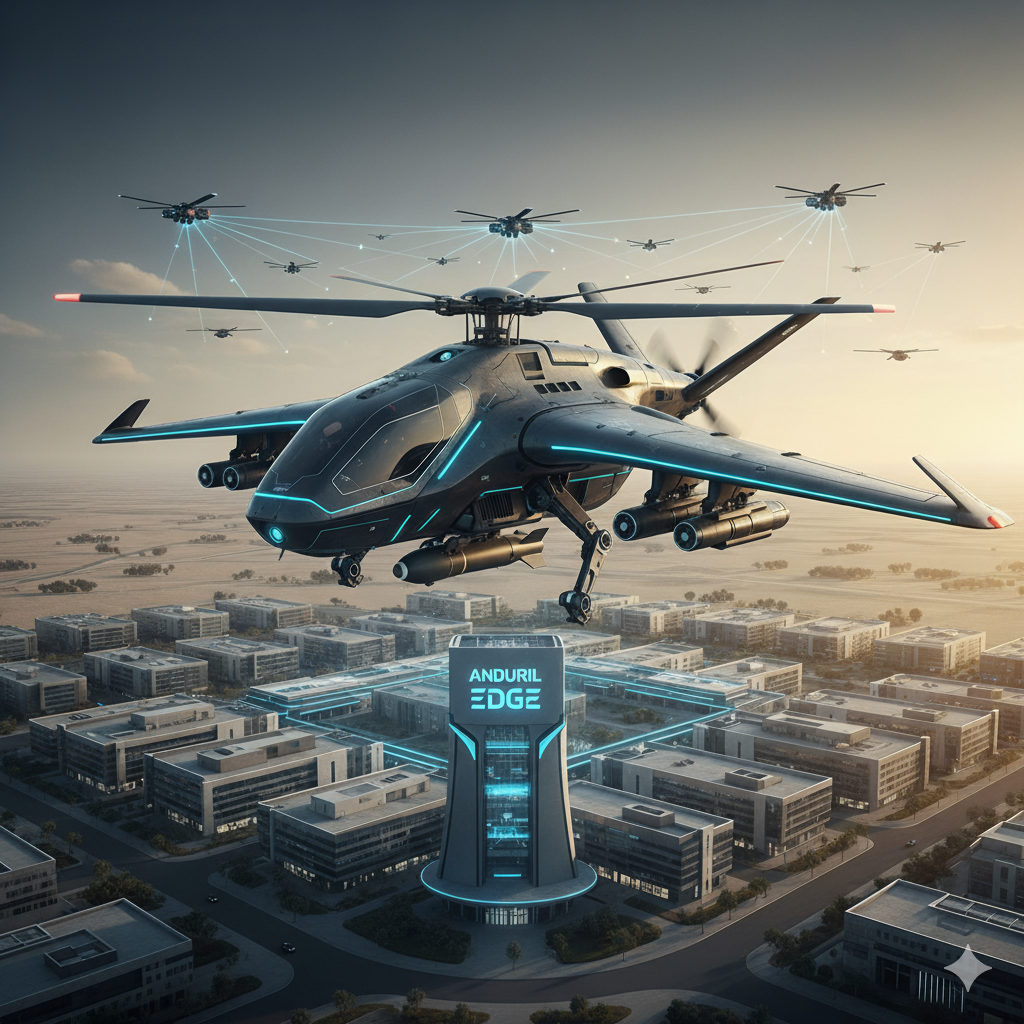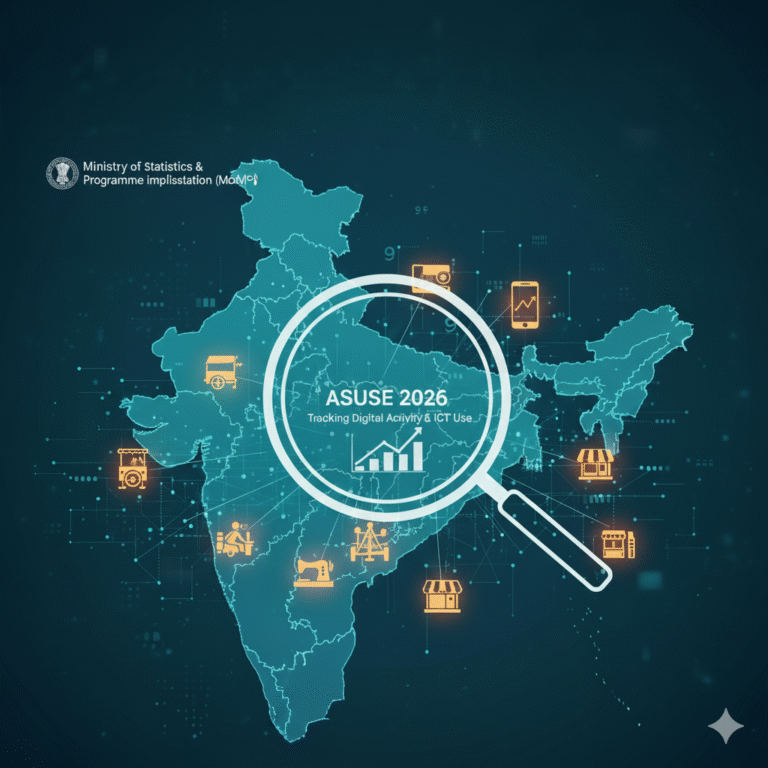Key Highlights
- Anduril Industries and UAE’s EDGE Group unveiled the Omen drone through a landmark joint venture, combining $850 million in Anduril technology development with $200 million in EDGE investment to establish Abu Dhabi manufacturing and R&D facilities.
- The Omen hybrid-electric VTOL drone carries three to five times the payload of typical Group 3 competitors, boasts range three to four times greater than standard platforms, and enables deployment from confined spaces without runways through tail-sitting vertical takeoff technology.
- Lattice AI, Anduril’s mission autonomy operating system, allows multiple Omen drones to coordinate in real-time, share sensor data autonomously, and execute complex swarm behaviors—fundamentally reshaping coordinated air operations and military strategy.
- The UAE confirmed acquisition of 50 initial Omen systems, establishing the production roadmap toward full-rate manufacturing by 2028 with split production between Abu Dhabi (regional customers) and Anduril’s Arsenal-1 facility in Ohio (US orders).
- The partnership deepens US-UAE strategic alignment rooted in the Abraham Accords while raising critical questions about autonomous weapons proliferation, export controls, cybersecurity vulnerabilities, and international humanitarian law compliance in an increasingly autonomous defense landscape.
Imagine a future where dozens of autonomous aircraft coordinate perfect formations across contested airspace, each one sharing sensor data, anticipating threats, and adapting strategy in milliseconds—without human intervention. That future isn’t science fiction anymore. It’s the Omen drone, unveiled in November 2025 through a landmark partnership between American defense innovator Anduril Industries and the UAE’s state-owned EDGE Group.
This alliance represents far more than a commercial transaction. It signals a seismic shift in how advanced defense capabilities proliferate globally, how AI and autonomy redefine warfare, and how geopolitical partnerships accelerate technological convergence. For policymakers, investors, and defense strategists, understanding this collaboration’s implications is essential for navigating the autonomous defense revolution.
Key Players and the Strategic Partnership
Anduril Industries: The Disruptor Redefining Defense
Founded in 2017 by Palmer Luckey—the visionary behind Oculus VR—Anduril represents a fundamentally different breed of defense contractor. Rather than following traditional Pentagon procurement cycles, Anduril’s Silicon Valley ethos emphasizes rapid iteration, pre-emptive product development, and aggressive adoption of AI and autonomy technologies.
Luckey and co-founders Brian Schimpf (CEO), Trae Stephens, Matt Grimm, and Joseph Chen brought deep tech expertise and startup mentality to an industry historically dominated by lumbering primes like Lockheed Martin and Raytheon. Anduril’s track record validates this approach: the company secured a $1 billion contract with US Special Operations Command for counter-drone systems, won $967 million in Air Force contracts, and demonstrated autonomous systems for border security that caught 55 attempted unauthorized entrants in its first 12 days. capitalcom

EDGE Group: UAE’s Defense Industrial Engine
Established in 2019 by consolidating 25+ Emirati defense companies, EDGE Group represents the UAE’s strategic commitment to tech sovereignty and defense independence. The conglomerate spans autonomous systems, precision-guided munitions, electronic warfare, and communications—essentially covering the full defense value chain.
EDGE’s momentum is staggering. The company generated $4.9 billion in contracts in 2024, with $2.1 billion attributed to exports—more than tripling from 2023. The June 2025 FALAJ-3 missile boat deal with Kuwait ($2.45 billion) became the largest naval export ever recorded in the Middle East, signaling EDGE’s emergence as a serious regional arms supplier.
EDGE’s competitive advantage stems from strategic foreign acquisitions—stakes in Estonia’s Milrem Robotics and Switzerland’s Anavia helicopter manufacturer—allowing the company to embed global best practices while localizing production.
The Joint Venture Structure
The EDGE-Anduril Production Alliance represents true partnership rather than mere licensing arrangement. Under the agreement:
- EDGE invests $200 million in Omen development and commits to regional production, sales, and sustainment.
- Anduril commits $850 million in prior technology development and establishes a 50,000-square-foot research, development, and simulation center in Abu Dhabi.
- Production split: UAE facility manufactures systems for regional and international customers; Anduril’s Arsenal-1 facility in Ohio handles US orders.
- Technology transfer: EDGE gains access to Anduril’s proprietary Lattice AI operating system—perhaps the partnership’s most strategically significant element.
- Governance coordination: Both firms coordinate business development globally while overseeing autonomous systems portfolio for military and civilian applications.
The Omen Drone: Game-Changing Specifications and Capabilities
The Omen represents revolutionary thinking in drone design, abandoning traditional multi-rotor or fixed-wing configurations for a hybrid hover-to-cruise architecture that combines unprecedented operational flexibility with impressive payload capacity.

Technical Architecture and Hybrid-Electric Propulsion
Omen employs a tail-sitting VTOL configuration, standing approximately 10 feet tall during takeoff and landing, then transitioning to horizontal flight. The aircraft features:
- Twin-rotor design with relatively long, slender main wings mounted toward the rear fuselage and canard foreplanes on either side of the nose.
- Twin-boom tail configuration extending from rear nacelles, reducing mechanical failure points compared to complex tilt-rotor systems.
- Hybrid-electric propulsion system: A gasoline-powered generator charges onboard batteries driving distributed electric propulsors, granting extended loiter times and dash speeds far exceeding pure battery-electric alternatives.
Performance Capabilities: Breaking Group 3 Boundaries
While exact specifications remain classified, Anduril disclosed remarkable comparative advantages:
- Payload capacity: Three to five times greater than typical Group 3 competitors (which normally carry 25-50 pounds), positioning Omen into performance territories traditionally reserved for much larger Group 4-5 platforms.
- Range: Three to four times greater than standard Group 3 designs, enabling missions requiring hundreds of kilometers of mission radius while maintaining hover capability for intelligence, surveillance, and reconnaissance (ISR) tasks.
- Runway independence: A two-person team can hand-launch and recover the aircraft from forest clearings, rooftops, naval vessels, or confined spaces—eliminating requirement for expensive infrastructure.
- Multi-payload flexibility: Omen can carry synthetic aperture radar (SAR), electro-optical (EO) sensors, infrared equipment, communications payloads, and electronic warfare systems simultaneously—capabilities normally requiring Group 5 platforms or small business jets.
- Power generation capacity: The series-hybrid architecture generates substantial excess power, enabling deployment as an airborne communications relay—”a cell phone tower that can fly”—restoring connectivity after infrastructure destruction.
Modular Architecture for Mission Flexibility
Omen’s open-architecture design enables rapid reconfiguration across military and dual-use missions. The same airframe transitions seamlessly from maritime patrol to border security to humanitarian logistics to disaster communications infrastructure.
This modularity addresses a critical gap in current military procurement: the inability to quickly adapt platforms to emerging mission requirements without years of additional development. Omen compressed development timelines from traditional 5-10 years to production-ready status within months.
Lattice AI: The Operating System Reshaping Autonomous Warfare
If Omen is impressive hardware, Lattice is the truly revolutionary element—Anduril’s proprietary AI-enabled autonomy software platform that fundamentally restructures how military organizations think about coordinated air operations.

Real-Time Autonomous Coordination
Lattice enables multiple Omen aircraft to autonomously coordinate flight paths, share sensor data, and adapt behavior in real time without human operator intervention. This creates unprecedented tactical advantages:
Distributed Sensing: Rather than centralized intelligence gathering, Omen swarms create networked sensor grids extending coverage across maritime approaches, border regions, and critical infrastructure—feeding unified operational pictures directly to command-and-control nodes.
Collaborative Decision-Making: When one drone’s sensors detect anomalies, the Lattice network instantly communicates findings to all networked aircraft, enabling adaptive responses—evading threats, focusing sensors, or executing coordinated engagement—in real time.
Emergent Capability: Individual drones possess inherent capabilities; collective Lattice networks exhibit emergent behaviors impossible for single platforms. Multiple Omen drones can identify targets, triangulate positions, predict movements, and recommend engagement strategies autonomously.
Mission Velocity: Traditional air operations require human pilots reviewing reconnaissance data, requesting commander approval, coordinating with other aircraft, and executing plans—inherently slow processes measured in hours. Lattice-enabled swarms execute equivalent missions in minutes or seconds.
Strategic Implications for Command Architecture
Lattice represents a fundamental departure from hierarchical military command structures. Rather than information flowing up chains of command and decisions flowing downward, Lattice enables distributed autonomous decision-making with human operators maintaining oversight rather than direct control.
This architectural shift has profound implications. Small expeditionary units without access to manned aviation or large drone teams can now deploy swarms of affordable, autonomous Omen aircraft providing capabilities historically requiring massive military infrastructure.
Production Timeline and Regional Expansion Strategy
The partnership’s execution timeline reflects both technological confidence and geopolitical urgency.
Development and Prototyping (2025-2027):
Anduril has already conducted propulsion system demonstrations. Full prototypes will undergo extensive testing in UAE airspace during 2026, with the companies conducting evaluations against mission requirements and operational concepts.
Initial Production (2027-2028):
The UAE confirmed acquisition of 50 initial Omen systems—a decisive investment anchoring production and accelerating development of future co-developed systems. This initial order guarantees production base, drives supply chain development, and provides revenue certainty for scaling manufacturing.
Production targets full-rate capability by end of 2028, meaning transition from prototype testing to serial production capable of delivering hundreds or thousands of units annually.
Geographic Production Split:
- Abu Dhabi facility: Manufactures systems for UAE, regional customers (Middle East, Africa, select Asian partners), and international allies outside US export control purview.
- Arsenal-1 facility (Ohio): Handles US military orders, ensuring compliance with US defense acquisition and domestic manufacturing requirements.
This split reflects sophisticated understanding of export control nuances. By establishing regional manufacturing capability, EDGE and Anduril position Omen for export to customers who might face complications with direct US procurement.
Workforce Development:
Plans include rotations of Emirati workers to United States facilities and vice versa, with potential involvement of British and Australian personnel. This international staffing model transfers knowledge, builds regional technical capability, and strengthens allied relationships.
Strategic and Geopolitical Implications
This partnership operates at the intersection of multiple strategic currents, each with enormous implications for regional stability, technology competition, and alliance dynamics.
US Strategic Interests and Abraham Accords Framework
The EDGE-Anduril partnership deepens US-UAE defense collaboration rooted in the Abraham Accords framework, Trump administration diplomacy that fundamentally reoriented Middle East geopolitics.
The original Abraham Accords (2020) normalized Israeli-UAE relations while establishing unprecedented Israeli-UAE military coordination. That arrangement was revolutionary; this partnership extends that logic: deepening US-UAE technology integration while positioning both nations to compete against Chinese and Russian autonomous systems proliferation.
President Trump’s May 2025 Abu Dhabi visit included announcement of $200 billion in new US-UAE commercial deals, with $1.4 trillion in broader investment commitments spanning AI infrastructure, semiconductors, energy, and frontier technologies. The Anduril-EDGE partnership exemplifies this investment framework—binding defense capabilities, manufacturing, and innovation ecosystems together.
UAE’s Tech Sovereignty Strategy
For Abu Dhabi, the partnership directly advances the National Defence Strategy 2023 and Fourth Industrial Revolution (4IR) Strategy, which explicitly identified robotics, autonomous vehicles, and AI as areas requiring sovereign domestic manufacturing capability.
The UAE model diverges from traditional arms procurement: rather than perpetual dependence on foreign suppliers, EDGE combines foreign technology partnerships with localized production to build indigenous defense industrial capacity. Over time, this creates technical expertise, supply chain resilience, and strategic independence—precisely what Dubai’s rulers have prioritized since 2019.
Omen represents the flagship demonstration of this strategy: cutting-edge technology, partnership with proven innovator, local production, technology transfer, and pathway to regional exports.
Regional Military Balance and Deterrence
The Middle East’s drone proliferation dynamics are already complex: Iran fields domestically-produced aerial systems; Turkey exports drones regionally; Israel possesses advanced autonomous capabilities. Omen adds a new player with sophisticated technology and serious production commitment.
The implications extend across multiple domains:
Maritime Security: Omen’s maritime patrol capabilities directly address UAE’s critical maritime dependencies—the Strait of Hormuz remains vital for global oil commerce, and autonomous persistent surveillance provides unprecedented awareness against threats.
Border Security: With maritime boundaries, land borders requiring monitoring, and extensive desert territory, autonomous drone swarms enable persistent coverage far exceeding traditional capabilities.
Counter-Drone Dominance: EDGE has developed sophisticated counter-UAS systems; integrating these with Omen offensive capabilities creates comprehensive drone-versus-drone dominance ecosystems.
Dual-Use Applications and Civilian Potential
While Omen emphasizes military utility, the design intentionally incorporates dual-use flexibility, addressing humanitarian, infrastructure, and commercial applications.
Humanitarian and Disaster Response
Omen’s communications relay capability—providing airborne cell tower functionality—offers transformative potential for disaster scenarios where infrastructure destruction disrupts emergency response. Following earthquakes, floods, or hurricanes, rapid Omen deployment could restore coordination capability in isolated areas.
Similarly, the extended range and multi-payload capacity enable rapid logistics delivery to isolated populations, search-and-rescue operations across extensive territories, and damage assessment missions informing humanitarian response prioritization.
Infrastructure Monitoring and Inspection
Long-range, persistent surveillance capabilities serve critical infrastructure inspection applications: power grid monitoring, pipeline integrity checks, environmental monitoring, and border infrastructure assessment.
Commercial Communications and Connectivity
In regions with limited telecommunications infrastructure, Omen’s airborne relay capability could provide temporary or permanent connectivity solutions for remote areas—addressing digital divides while generating revenue streams.
Critical Challenges and Controversies
Despite impressive capabilities, the EDGE-Anduril partnership confronts serious challenges spanning regulatory compliance, strategic stability, and international humanitarian concerns.
Autonomous Weapons Proliferation and Export Controls
The most significant controversy centers on potential proliferation of autonomous weapons to problematic actors. While EDGE and Anduril operate within established US-UAE defense frameworks, Omen represents the precise weapons category most concerning to international humanitarian organizations.
The international community has expressed alarm about lethal autonomous weapon systems (LAWS) proliferation. The UN Convention on Certain Conventional Weapons (CCW) has attempted to develop governance frameworks, with 129 countries calling for legally binding instruments prohibiting autonomous weapons. However, enforcement mechanisms remain weak, and major defense powers—including the US—continue autonomous systems development.
Complicating export control architecture:
- Dual-use ambiguity: Omen’s humanitarian applications, communications capabilities, and commercial surveillance functions blur distinctions between military and civilian platforms.
- Regional customer base: Once production occurs in Abu Dhabi, end-use verification becomes complicated—customers could theoretically modify systems or transfer them to prohibited actors.
- Wassenaar Arrangement limitations: The multilateral export control regime attempting to prevent sensitive weapons technology proliferation faces persistent compliance gaps and lacks mechanisms for controlling modified commercial components that can enable autonomous weapons.
Cybersecurity Vulnerabilities
Omen’s reliance on Lattice AI and networked autonomous coordination creates cybersecurity attack surfaces:
Network compromise: If adversaries penetrate Lattice command networks, they could theoretically redirect entire drone swarms or extract sensitive operational data.
AI algorithm manipulation: Adversaries feeding corrupted sensor data or manipulating training datasets could misdirect autonomous decision-making—a particularly dangerous attack vector for military systems.
Supply chain vulnerabilities: Electronics suppliers, software developers, and component manufacturers represent potential compromise points—a risk particularly acute in globally distributed defense manufacturing.
International standards for autonomous weapons cybersecurity remain underdeveloped, creating gaps between capability and defensive readiness.
International Humanitarian Law Compliance
Fundamental questions persist about autonomous weapons compliance with laws of armed conflict, particularly regarding distinction between combatants and civilians, proportionality of force, and accountability for autonomous decision-making.
International humanitarian law requires meaningful human control in targeting decisions. While Anduril emphasizes human operators maintaining oversight of Lattice-enabled systems, the degree of human involvement remains ambiguous—particularly during real-time autonomous swarm operations where human reaction times may prove insufficient.
Regulatory and Diplomatic Uncertainty
The regulatory environment for autonomous defense systems remains uncertain. While no formal ban on autonomous weapons exists internationally, growing advocacy for restrictions—particularly from humanitarian organizations and numerous nations—could constrain future sales, production, or deployment.
US-UAE Defense Partnership Evolution
The EDGE-Anduril partnership represents the latest chapter in three decades of deepening US-UAE defense relationships, fundamentally accelerated by Trump-era diplomacy and Abraham Accords frameworks.
Historical Progression:
- 1990s-2000s: Traditional arms sales relationship—US supplying advanced fighter jets (F-16s), air defense systems, and precision munitions to UAE military.
- 2010s: Emergence of UAE as regional technology hub; EDGE establishment (2019) signaling shift from procurement to production.
- 2020-2024: Abraham Accords reshaping region; UAE-Israel military coordination; tech partnerships expanding beyond traditional defense into AI, semiconductors, energy.
- 2025 onwards: Strategic partnership deepening through joint development, co-production, and technology transfer—exemplified by Omen.
Spillover Effects on Regional Innovation Ecosystems
The partnership generates spillover benefits across broader regional technology ecosystems. EDGE’s partnerships with 20+ international defense firms, combined with Anduril’s emerging Middle East presence, attract talent, capital, and expertise to Abu Dhabi.
This ecosystem development—manifested through research centers, manufacturing facilities, and talent programs—positions UAE as an autonomous systems hub for Middle Eastern defense innovation. Competitors and partners alike must increasingly consider UAE capabilities and manufacturing capacity when planning regional strategies.
Potential Winners and Losers in the Autonomous Defense Revolution
Sectors and Actors Positioned to Benefit:
US and Allied Defense Contractors: Companies supplying components, software, sensor systems, or manufacturing services to Omen production gain revenue and technological positioning.
Regional SMEs: Small and medium enterprises in UAE, allied nations, and developing countries gain access to world-class technology through EDGE partnerships and subcontracting opportunities.
Infrastructure Protection Industries: Counter-drone, cyber defense, and electronic warfare companies face surging demand as autonomous aircraft proliferation accelerates.
Defense-Tech Startups: Entrepreneurs developing complementary autonomous systems, swarm coordination algorithms, or counter-UAS solutions find accelerating market demand.
Actors Facing Strategic Challenges:
Traditional Defense Primes: Companies like Lockheed Martin, Raytheon, and Boeing face margin pressure as customers increasingly demand software-defined, rapidly-iterable systems rather than traditional hardware-centric platforms.
Autonomous Weapons Critics: Humanitarian organizations, non-aligned nations, and human rights advocates facing increased autonomous weapons proliferation with limited regulatory mechanisms for constraint.
Adversarial Powers: Nations lacking autonomous systems expertise or manufacturing capability face expanding technology gaps as US-UAE partnerships accelerate knowledge transfer and production capacity establishment.
Recommendations for Policymakers and Strategic Stakeholders
US Policymakers:
Monitor technology transfer implications carefully. While alliance deepening with UAE carries strategic benefits, ensuring that proprietary Anduril technology receives adequate export controls and end-use verification safeguards remains critical.
Advocate for international norms around autonomous weapons development. Rather than unilateral restrictions—which create disadvantages—work multilaterally to establish shared governance frameworks through UN bodies, CCW mechanisms, and bilateral agreements.
Invest in cybersecurity standards for autonomous defense systems. The technology sector leads far ahead of regulation; proactive development of security architectures prevents future vulnerabilities.
UAE and Regional Leaders:
Leverage EDGE-Anduril success to establish UAE as regional autonomous systems hub. Incentivize complementary technology partnerships, startup ecosystems, and research institutions to build comprehensive innovation infrastructure.
Develop responsible use frameworks emphasizing humanitarian applications and strict end-use verification procedures. Establishing reputation for responsible technology stewardship creates competitive advantages and reduces regulatory scrutiny.
Technology Companies:
Anticipate autonomous weapons as foundational technology category. Companies developing complementary systems (swarm coordination, counter-autonomy, AI safety), sensor technologies, or manufacturing solutions face decades of growing demand.
Embed ethics and security into autonomous systems architecture from inception. Regulatory frameworks, public scrutiny, and potential customer demands for responsible systems will only intensify.
Conclusion

The EDGE-Anduril partnership unveiling Omen represents a watershed moment in autonomous defense technology. For the first time, cutting-edge AI-enabled autonomy, revolutionary hybrid-electric propulsion, and sophisticated coordination systems are entering production at a scale and cost previously unimaginable.
The implications extend far beyond UAEs military capability or alliance dynamics. Omen signals how autonomous systems fundamentally reshape warfare, deterrence, and strategic competition. For investors, the partnership exemplifies a profound shift in defense contracting toward startup-driven innovation displacing traditional primes. For policymakers, it underscores urgency around autonomous weapons governance before proliferation accelerates beyond regulatory capacity.
For humanity more broadly, this partnership embodies the dual possibilities of autonomous technology: extraordinary potential for humanitarian applications balanced against existential risks if autonomous weapons proliferate without adequate constraints.









+ There are no comments
Add yours